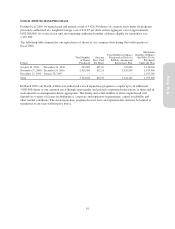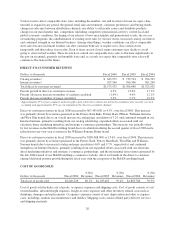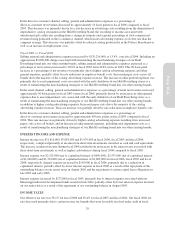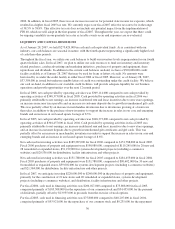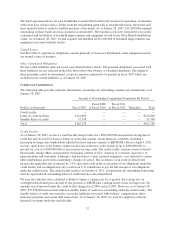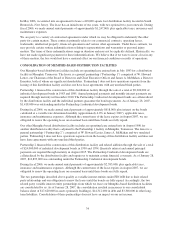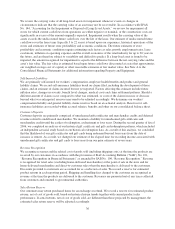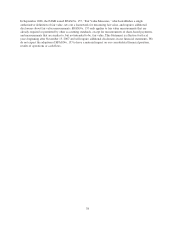Pottery Barn 2006 Annual Report Download - page 40
Download and view the complete annual report
Please find page 40 of the 2006 Pottery Barn annual report below. You can navigate through the pages in the report by either clicking on the pages listed below, or by using the keyword search tool below to find specific information within the annual report.
compared to fiscal 2004, we saw a rate decrease in cost of merchandise driven by increased full-price selling in
the Pottery Barn and Williams-Sonoma brands, partially offset by the write-down of impaired merchandise
inventories associated with transitioning the merchandising strategies of our Hold Everything brand into our
other existing brands and increased costs associated with the 2005 daily store replenishment program.
In the direct-to-customer channel, cost of goods sold as a percentage of direct-to-customer net revenues remained
relatively flat in fiscal 2005 compared to fiscal 2004. This was primarily due to rate increases in cost of goods
and occupancy expenses, offset by a rate reduction in shipping costs. The rate increase in cost of goods was
primarily due to a furniture-driven rate increase, as well as the write-down of impaired merchandise inventories
associated with transitioning the merchandising strategies of our Hold Everything brand into our other existing
brands. The rate increase in occupancy expenses was primarily a function of higher distribution occupancy
expenses resulting from increased distribution leased square footage versus fiscal 2004. The rate reduction in
shipping costs was primarily due to the successful refining of our furniture delivery network, including the late
2004 in-sourcing of our line-haul management and cost efficiencies gained from our east coast distribution
center, partially offset by a year-over-year increase in fuel surcharges.
SELLING, GENERAL AND ADMINISTRATIVE EXPENSES
Dollars in thousands Fiscal 2006
% Net
Revenues Fiscal 2005
% Net
Revenues Fiscal 2004
% Net
Revenues
Selling, general and administrative expenses $1,159,786 31.1% $1,090,392 30.8% $961,176 30.6%
Selling, general and administrative expenses consist of non-occupancy related costs associated with our retail
stores, distribution warehouses, customer care centers, supply chain operations (buying, receiving and
inspection), and corporate administrative functions. These costs include employment, advertising, third party
credit card processing and other general expenses.
Due to their distinct distribution and marketing strategies, we experience differing employment and advertising
costs as a percentage of net revenues within the retail and direct-to-customer channels. Store employment costs
represent a greater percentage of retail net revenues than employment costs as a percentage of net revenues
within the direct-to-customer channel. However, catalog advertising expenses are greater within the
direct-to-customer channel than the retail channel.
Fiscal 2006 vs. Fiscal 2005
Selling, general and administrative expenses increased by $69,394,000, or 6.4%, over fiscal 2005. Including the
charge of approximately $16,000,000 resulting from both the expense associated with stock-based compensation
(including the implementation of SFAS 123R) and the favorable net impact of Unusual Business Events, selling,
general and administrative expenses as a percentage of net revenues increased to 31.1% in fiscal 2006 from
30.8% in fiscal 2005. This 30 basis point increase as a percentage of net revenues was primarily driven by
increased employment costs due to the recognition of stock-based compensation expense, the growth of the
emerging brands and expense incurred in connection with the departure of our former Chief Executive Officer,
partially offset by lower incentive compensation compared to fiscal 2005. This increase was further driven by
higher asset disposals related to our information technology systems and higher asset impairment charges related
to our retail stores (including two mid-market Williams-Sonoma Home stores), partially offset by a change in
estimate for recording income associated with unredeemed gift certificates, the settlement of the Visa/
MasterCard litigation and the elimination of expenses associated with the Hold Everything brand.
In the retail channel, selling, general and administrative expenses as a percentage of retail net revenues increased
approximately 10 basis points in fiscal 2006 versus fiscal 2005, primarily driven by an increase in employment
costs associated with the growth in the emerging brands. This increase was partially offset by a change in
estimate for recording income associated with unredeemed gift certificates and a reduction in expense associated
with retail asset impairment charges as compared to prior year, which had higher retail asset impairment charges
associated with the early shutdown of our Hold Everything stores.
28



